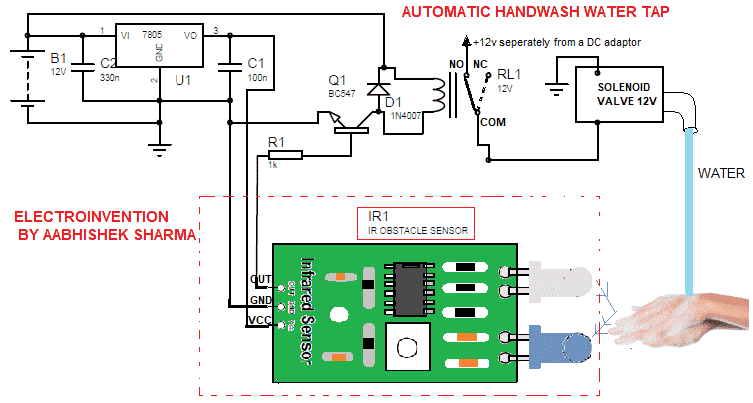Hello Engineers. Here is another automation and home utility-related project ” Automatic smart washbasin tap controller”. An untouched and automatic water tap is a necessity to prevent virus contamination even after washing hands. Also, in the current coronavirus threat, we need to make sure of our hygiene and immunity. Although, we have a lot of handsfree automatic water tap controller circuits available on the internet with different ideas. Today, I am going to introduce a better and easier circuit which is much simpler and without any microcontrollers. So, let’s start with our topic automatic smart washbasin handwash water tap controller / Smart washbasin tap controller / automatic handwash water tap system / smart washbasin tap controller circuit.
Circuit Diagram for smart washbasin tap controller

Below will be the materials and working explanations.
Materials
- C1 100n- 1pc
- C2 330n – 1pc
- U1 LM7805 Voltage regulator – 1pc
- Q1 BC547 – 1pc
- R1 1K
- D1 1N4007
- RELAY 12V
- Solenoid Valve 12v Buy at cheap
- IR Obstacle sensor Buy from Quartz Components at Rs.58 Very cheap, means $0.7 I recommend
Working
The schematic above is employing an IR Obstacle sensor as a detector and the solenoid valve to control the water flow. The circuit is being powered by a 12v battery as a power source, but you can use any 12v dc adapter.
There is a solenoid valve connected to the relay COM pin. As soon as the hand comes in front of the sensor, the IR sensor detects them.
It does detection work by the principle depending upon the working of the IR encoder and receiver. Once, the hand comes in the range with the sensor the IR light emitted by the emitter falls and strikes back from the hands. This reflected IR radiation is sensed by the IR receiver LED in the sensor. The IR sensor then gives a TTL Output to the transistor Q1’s base to turn it ON.
This makes the relay turn ON. After that, the relay makes the solenoid valve connected to a power source connected to the NO pin that leads to water flow.
If hands are removed, the sensor stops the transistor supply making relay to turn off and the solenoid valve stops getting supply too. The water flow then stops as the relay COM pin gets back to NC. This makes solenoid to turn off and water supply is off.
Use a separate 12V DC power for the solenoid valve. For batteries, you can use anything maybe lithium-ion 11.1v or lead-acid12v (1.2 ah will also be enough) or anything according to your convenience. You have to also add a charging facility according to the battery type. Save water, Prevent germs, Save Health, Save the earth!
I hope you guys liked it. Do mention in the comments. Also, subscribe to our newsletter to get the latest post updates automatically.


Please tell us how to make ir proximity sensor ciruit taht work perfectly in sunlight too. with all the necessarydetails. and how its work with all components detail
Hello Tushar, thanks for visiting. I will post about that.
THIS PROJECT IS AWESOME, AND CHEAP I WILL DEFENITLY MAKE THIS ONE. THANK YOU SO MUCH FOR SHARING THIS IDEA. WATING FOR MORE…..
Amazing! The idea of a smart washbasin tap controller is really very interesting. I really liked this idea a lot. You have also successfully explained the working of this tap with a diagram in this article. These kinds of taps are the need of the hour. Thank you for sharing this article with us. It was a pleasure reading your article.
Nice project.but can u say that this project better then micro controller if yes then why.
Yes, of course, for this small work, why to use a microcontroller and this is a better cheap , easy and small solution.
It my pleasure to be in forum
Hello Owen, Thanks for visiting. You are welcome here.
U can use washing machine solenoid valve. Which can work direct on 230v ac
Hello Suresh, Thanks for visiting. Nice suggestion washing machine solenoid will be better rather than having a separate 12v supply for the solenoid.As it can directly work with domestic AC supply 220-230v. The problem only as it can be dangerous if a starter is doing the project or someone less expirienced is doing, as 220v can definitely harm someone if not done accurately.
By the way, your suggestion is good.
I need solenoid. For water.
Thanks for visiting. Buy solenoid valve from amazon.